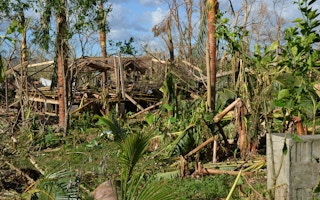Lately, compensation has become one of the most contentious issues at the U.N. climate talks. At the Doha climate conference (COP - Conference of Parties) in 2012, the developing countries strongly confronted the rich nations blaming them for unprecedented climate impacts due to their inaction.
It was the year when Africa, which was still reeling from the effects of a severe drought in East Africa region, got hit by an acute food crisis in the Sahel region affecting tens of millions. The United States was also struck by an extreme climatic disaster- Hurricane Sandy. It experienced the second-costliest hurricane in its history causing severe damage in New Jersey and New York, and affecting 24 states, amounting to over $68 billion by some estimates.
As if that wasn’t enough, amid climate talks in the city of Doha, Typhoon Bopha, the 16th major storm system of the year, battered the Philippines, killing at least a thousand and affecting over 6 million people. In Doha, when developing countries sensed the burial of the Kyoto Protocolby developed countries and no further commitment on finance coming through, Bopha acted as a trigger to demand action to address climate induced ‘loss and damage’.
The group of Small Island Developing States (SIDS) that had been leading on the issue saw the groups of Least Developed Countries (LDCs), African countries and a few others joining the chorus to strongly demand compensation. Their demands were supported unequivocally by ActionAid, CARE and WWF among others and media effectively echoed their voices.
In Doha, the rich nations then agreed to set up an international mechanism in the following year but did not include the compensation word, due to the fear of litigations and future liability.
Justice goes beyond solidarity
Loss and damage to property, territory, lives and livelihoods results from both insufficient mitigation and failure of measures such as disaster risk reduction and adaptation. Cyclone Pam in Vanuatu is yet another harsh reminder that undeniably we have reached the era of ‘loss and damage.’
In previous reports, we underlined how acting on climate change is both a moral and legal obligation under the United Nations Framework Convention on Climate Change (UNFCCC).
The responsibility of developed countries to compensate can also be derived from the harm caused outside their jurisdiction under international environmental law; the no-harm rule in customary international law; and international human rights law, including the right to life, food and the highest attainable standard of health.
In the light of that, a recent report by Friends of the Earth underlines the need for a compensation fund and redress process for loss and damage.
Aid from the developed world to help Vanuatu is welcomed, but the developed world must also admit that addressing the impacts of climate change is part of their obligation. The act of solidarity must be combined with their responsibility to ensure justice to those who had no role in causing the crisis.
Preparedness pays
“
Aid from the developed world to help Vanuatu is welcomed, but the developed world must also admit that addressing the impacts of climate change is part of their obligation. The act of solidarity must be combined with their responsibility to ensure justice to those who had no role in causing the crisis.
Cyclone Pam, which made landfall on March 13, was the strongest storm since the devastating Super Typhoon Haiyan hit the Philippines in 2013, yet the death toll remained exceptionally low. Compared to the situation several years ago, the number of deaths, particularly from cyclones is coming down due to effective early warning, communication and evacuation systems in many countries.
It underpins the need to invest in disaster risk reduction (DRR) measures and adaptation strategies on a war-footing basis. It is well established that every dollar spent in risk reduction saves seven dollars in emergency response.
However, DRR and adaptation efforts need to be up-scaled in accordance with the current high-emission trajectories that are likely to lead to a global average temperature increase of around 4 degrees Celsius, to avoid catastrophic impacts on people and ecosystems.
Taking that into account, the Adaptation Gap Report 2014 by United Nations Environment Programme for Development (UNEP) argues that adaptation in developing countries could cost $150 billion per year by 2025-2030 and $250 billion to $500 billion per year by 2050.
It also emphasises that finance, technology and knowledge are key to realise adaptation potential and reduce risks and impacts in both the short and long term. However, the report says, public adaptation-related finance flows—based on available data to date— to developing countries are estimated at around $21.6 billion in 2012-13.
Connecting the dots
The World Humanitarian Summit (WHS) in May 2016 in Istanbul will set the agenda for how we can collectively meet the humanitarian challenges of the future. The consultations in the lead up to the Summit are focused on reducing vulnerability and managing risk as one of its four core themes.
The latest scoping paper acknowledges effects of climate change as one of the future challenges that contributes to increasing vulnerability to shocks and stresses. However, the document doesn’t give any explicit reference to climate-induced slow-onset disasters such as sea level rise, ocean acidification, salinisation, and loss of biodiversity.
The humanitarian system needs to unambiguously recognise that climate-induced loss and damage – both extreme weather events and slow-onset events – is a humanitarian crisis.
The corollary of this would be to link and own up the processes being undertaken by the Warsaw International Mechanism on Loss and Damage (WIM) established under UNFCCC in 2013. The interim Executive Committee has already developed an initial two year work plan, which will soon be put to action once the new committee takes charge.
We need to connect the existing processes proactively to make sure that the efforts being made by one institution are informed and complemented by other related institutions and communities. The three-fold higher cost of humanitarian assistance compared to the last decade cannot and shouldn’t be fulfilled by the aid alone.
Vanuatu will need billions of dollars to repair damaged infrastructure and houses, restore water and power supplies, and revive destroyed agriculture. The increasing cost of responding to climatic impacts must therefore be met by the compensation amount that rich countries are obligated to provide.
In the view of extensive damage caused by the Cyclone Pam, the Climate Vulnerable Forum– a group of 20 countries highly vulnerable to climate change, which Vanuatu is part of - renewed its call to limit global warming to 1.5 degrees Celsius to prevent unmanageable suffering and devastation.
The efficacy of the humanitarian system therefore hinges on how the climate deal in Paris late this year will limit the temperature rise and provide resources for adaptation, while ensuring justice for the impacted people.
Harjeet Singh is the global lead on issues of climate change and resilience for ActionAid international. This post was originally published on the Thomson Reuters Foundation site.











